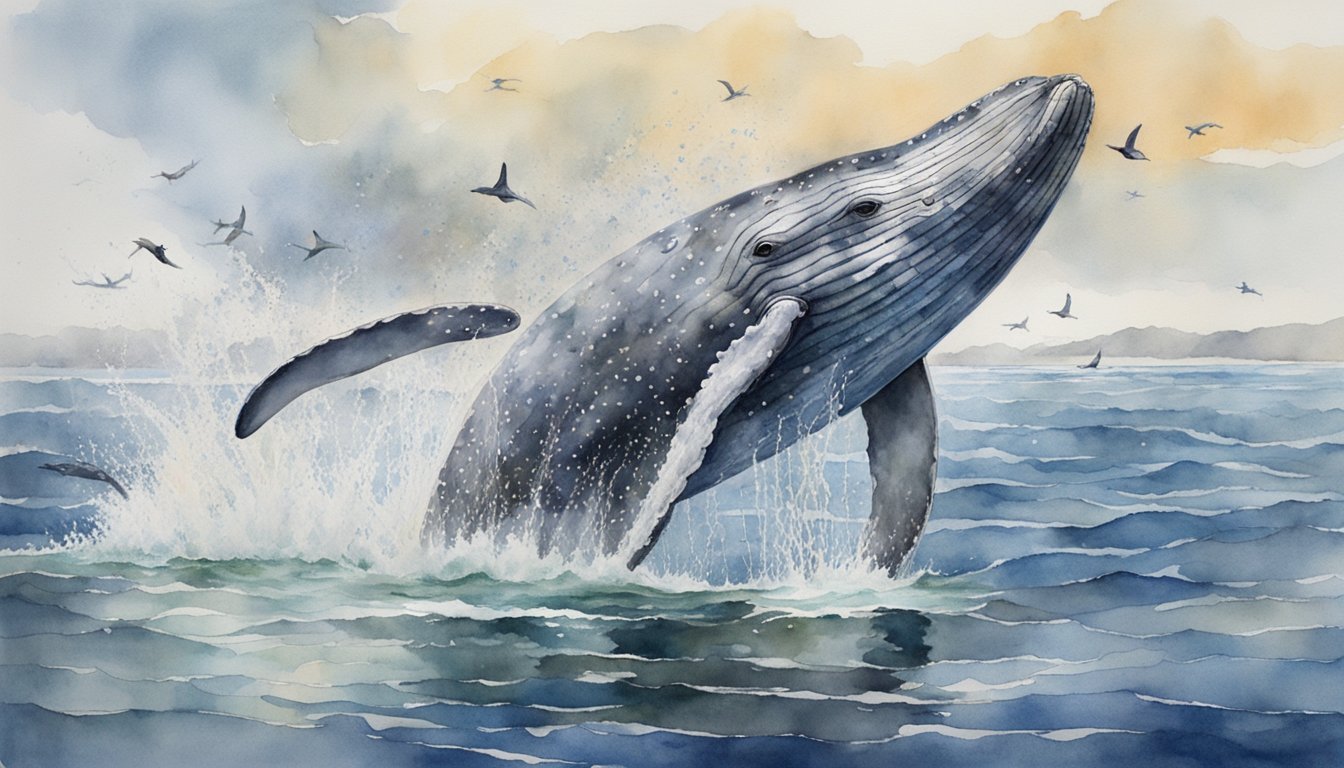Gray Whale Fundamentals
The gray whale is a majestic marine mammal known for its distinctive baleen and migratory behaviors. This section will explore its unique anatomy and where it fits within the cetacean species classification.
Anatomy and Characteristics
The gray whale, scientifically known as Eschrichtius robustus, belongs to the family Eschrichtiidae and is a type of baleen whale. These mammals can grow up to lengths of 49 feet and weigh as much as 90,000 pounds, with females generally larger than males. They feature a robust body covered with characteristic gray patches and white mottling on their dark skin. Notable for lacking a dorsal fin, their back instead has a series of knuckles that lead to their flukes, which span roughly 10-11 feet in width. Gray whales have a double blowhole on top of their heads and use baleen plates, rather than teeth, to filter feed in the ocean.
- Body: Mottled gray, streamlined with a thin layer of blubber
- Head: Broad and flat with small eyes located just above the corners of the mouth
- Baleen Plates: Used for filter-feeding in sediment
- Flukes: 10-11 feet wide with a notched center
Species Classification
Gray whales are the sole living members of the family Eschrichtiidae. They belong to the order Cetacea, providing a clear definition of their placement within the mammal classification. Gray whales are noted for undertaking significant migrations, covering thousands of miles between their breeding grounds in the warm waters of Mexico to their feeding grounds in the Arctic. These lengthy migrations are essential behaviors for the species, allowing them to access rich feeding areas that sustain them throughout the year. Known as the Pacific gray whale or California gray whale, their history of interaction with humans along coastlines has made them a focal point for conservation and marine mammal watching.
- Order: Cetacea
- Family: Eschrichtiidae
- Common Names: Pacific gray whale, California gray whale, Korean gray whale
The gray whale possesses remarkable traits evolved over millennia, making it a key species in the marine ecosystem and a subject of wonder for marine enthusiasts.
Behavior and Ecology

The behavior and ecology of gray whales are characterized by specialized feeding habits, extensive migratory patterns, and unique reproduction behaviors. These mammals are also the focus of various conservation efforts due to their ecological importance and history of endangerment.
Feeding Habits
Gray whales are often referred to as bottom feeders, taking advantage of benthic ecosystems. Their diet primarily consists of small crustaceans such as amphipods and larval crabs. They exhibit a unique feeding technique known as suction feeding, disturbing the sea floor by rolling on their sides and using their baleen to filter food from the sediment.
Migratory Patterns
One of the most remarkable characteristics of gray whales is their migration route, which is one of the longest of any mammal, reaching up to 12,000 miles round-trip. They travel from their feeding grounds in the nutrient-rich waters of the Bering and Chukchi Seas to the warmer breeding lagoons of Baja California, Mexico. This journey is critical for their survival, ensuring access to food and breeding grounds.
Reproduction and Lifespan
Gray whales engage in mating behavior in the warm lagoons off the coast of Baja California. After a gestation period of about 13.5 months, females give birth to calves in these sheltered waters. Calves are nursed for approximately seven months before making their first migration north to the feeding grounds. The average lifespan of a gray whale is estimated to be between 55 and 70 years.
Conservation Efforts
Despite being removed from the endangered species list, gray whales face ongoing threats such as entanglement in fishing gear, habitat degradation, and potential environmental changes in their feeding areas. Conservation actions under the Marine Mammal Protection Act and the Endangered Species Act have been instrumental in their recovery, and the International Whaling Commission regulates hunting to prevent population declines.

